Chronic, complete cervical6-7 cord transection: distinct autonomic and cardiac deficits
- PMID: 29470149
- PMCID: PMC6032093
- DOI: 10.1152/japplphysiol.01104.2017
Chronic, complete cervical6-7 cord transection: distinct autonomic and cardiac deficits
Abstract
Spinal cord injury (SCI) resulting in tetraplegia is a devastating, life-changing insult causing paralysis and sensory impairment as well as distinct autonomic dysfunction that triggers compromised cardiovascular, bowel, bladder, and sexual activity. Life becomes a battle for independence as even routine bodily functions and the smallest activity of daily living become major challenges. Accordingly, there is a critical need for a chronic preclinical model of tetraplegia. This report addresses this critical need by comparing, for the first time, resting-, reflex-, and stress-induced cardiovascular, autonomic, and hormonal responses each week for 4 wk in 12 sham-operated intact rats and 12 rats with chronic, complete C6-7 spinal cord transection. Loss of supraspinal control to all sympathetic preganglionic neurons projecting to the heart and vasculature resulted in a profound bradycardia and hypotension, reduced cardiac sympathetic and parasympathetic tonus, reduced reflex- and stress-induced sympathetic responses, and reduced sympathetic support of blood pressure as well as enhanced reliance on angiotensin to maintain arterial blood pressure. Histological examination of the nucleus ambiguus and stellate ganglia supports the profound and distinct autonomic and cardiac deficits and reliance on angiotensin to maintain cardiovascular stability following chronic, complete cervical6-7 cord transection. NEW & NOTEWORTHY For the first time, resting-, reflex-, and stress-induced cardiovascular, autonomic, and hormonal responses were studied in rats with chronic, complete C6-7 cord transection. Loss of supraspinal control of all sympathetic preganglionic neurons reduced cardiac sympathetic and parasympathetic tonus, reflex and stress-induced sympathetic responses, and sympathetic support of blood pressure as well as enhanced reliance on angiotensin to maintain arterial blood pressure. Histological examination supports the distinct deficits associated with cervical cord injury.
Keywords: blood pressure regulation; parasympathetic nervous system; sympathetic nervous system; tetraplegia.
Figures
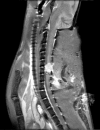
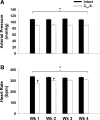


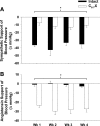
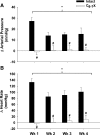


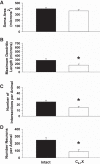
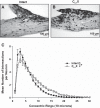
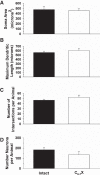
Similar articles
-
Direct comparison of cervical and high thoracic spinal cord injury reveals distinct autonomic and cardiovascular consequences.J Appl Physiol (1985). 2020 Mar 1;128(3):554-564. doi: 10.1152/japplphysiol.00721.2019. Epub 2020 Jan 30. J Appl Physiol (1985). 2020. PMID: 31999525 Free PMC article.
-
Spinal cord injury alters purinergic neurotransmission to mesenteric arteries in rats.Am J Physiol Heart Circ Physiol. 2020 Feb 1;318(2):H223-H237. doi: 10.1152/ajpheart.00525.2019. Epub 2019 Nov 27. Am J Physiol Heart Circ Physiol. 2020. PMID: 31774690 Free PMC article.
-
Structural remodeling of the heart and its premotor cardioinhibitory vagal neurons following T(5) spinal cord transection.J Appl Physiol (1985). 2014 May 1;116(9):1148-55. doi: 10.1152/japplphysiol.01285.2013. Epub 2014 Mar 7. J Appl Physiol (1985). 2014. PMID: 24610530 Free PMC article.
-
Vascular dysfunctions following spinal cord injury.J Med Life. 2010 Jul-Sep;3(3):275-85. J Med Life. 2010. PMID: 20945818 Free PMC article. Review.
-
Cardiovascular consequences of loss of supraspinal control of the sympathetic nervous system after spinal cord injury.Arch Phys Med Rehabil. 2000 Apr;81(4):506-16. doi: 10.1053/mr.2000.3848. Arch Phys Med Rehabil. 2000. PMID: 10768544 Review.
Cited by
-
Autonomic Dysreflexia in Spinal Cord Injury: Mechanisms and Prospective Therapeutic Targets.Neuroscientist. 2024 Oct;30(5):597-611. doi: 10.1177/10738584231217455. Epub 2023 Dec 12. Neuroscientist. 2024. PMID: 38084412 Free PMC article. Review.
-
Direct comparison of cervical and high thoracic spinal cord injury reveals distinct autonomic and cardiovascular consequences.J Appl Physiol (1985). 2020 Mar 1;128(3):554-564. doi: 10.1152/japplphysiol.00721.2019. Epub 2020 Jan 30. J Appl Physiol (1985). 2020. PMID: 31999525 Free PMC article.
-
Cardiac neuromodulation with acute intermittent hypoxia in rats with spinal cord injury.J Physiol. 2025 Mar;603(7):2139-2156. doi: 10.1113/JP287676. Epub 2025 Mar 22. J Physiol. 2025. PMID: 40120122 Free PMC article.
-
Robotic-assisted versus free-hand techniques in adult spinal deformity surgery: a comparative analysis of postoperative outcomes.J Robot Surg. 2025 Jul 11;19(1):375. doi: 10.1007/s11701-025-02543-7. J Robot Surg. 2025. PMID: 40643760 Free PMC article.
-
Spinal cord injury alters purinergic neurotransmission to mesenteric arteries in rats.Am J Physiol Heart Circ Physiol. 2020 Feb 1;318(2):H223-H237. doi: 10.1152/ajpheart.00525.2019. Epub 2019 Nov 27. Am J Physiol Heart Circ Physiol. 2020. PMID: 31774690 Free PMC article.
References
-
- Berkowitz M, O’Leary PK, Kruse DL, Harvey C. Spinal Cord Injury: An Analysis of Medical and Social Costs. New York: Demos Medical Publishing, 1998.
Publication types
MeSH terms
Grants and funding
LinkOut - more resources
Full Text Sources
Other Literature Sources
Medical

